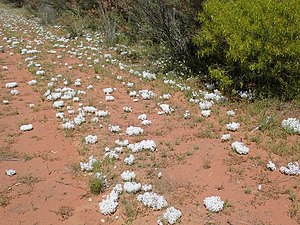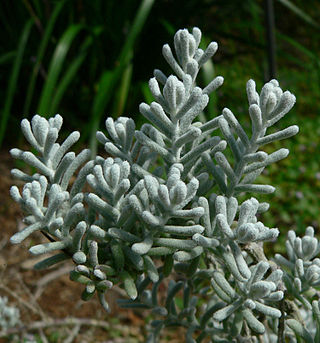
Maireana sedifolia, also known as the bluebush or pearl bluebrush is a compact shrub endemic to Australia, and found in New South Wales, Victoria, South Australia, Western Australia, and the Northern Territory. It is used in pasture and as a garden plant where it is popular due to its distinctive grey foliage.

Akania is a monotypic genus in the family Akaniaceae. The single species, Akania bidwillii (turnipwood), is a tree that is native to subtropical and warm-temperate coastal rainforests in New South Wales and Queensland in Australia. It is known locally as turnipwood because when it is cut down it gives off a foul odour similar to turnips. It blooms with white or pink, fragrant flowers in the spring, and the fruit is a dull-red round capsule that dries down and releases 1-2 seeds. Panicles usually 8–15 cm long; pedicels 5–20 mm long. Calyx 3–4 mm long. Corolla 8–12 mm long.

Daphnandra johnsonii, also known as the Illawarra socketwood, is a rare rainforest tree in the Illawarra district of eastern Australia.
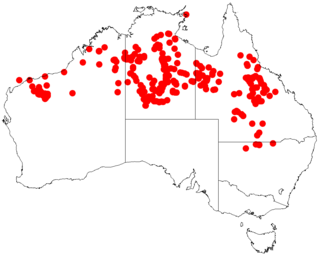
Acacia cowleana, Halls Creek wattle, is a northern Australian native shrub. It is a flowering plant with yellow flowers that only open in winter. Its origin is the Northern Australia's dry tropics. It belongs to the genus of Acacia.

Psydrax oleifolia, commonly known as wild lemon or brush myrtle, is a species of shrub or small tree in the family Rubiaceae. It is endemic to eastern and inland Australia,.

Isotoma petraea, commonly known as rock isotome, is a small, herbaceous plant in the family Campanulaceae occurring in arid regions of Australia. It has single, purplish-blue flowers on smooth, slender branches from February to November.
Baumea arthrophylla(now known as Machaerina arthrophylla) is a flowering plant in the sedge family, Cyperaceae that is native to many states and territories of Australia.
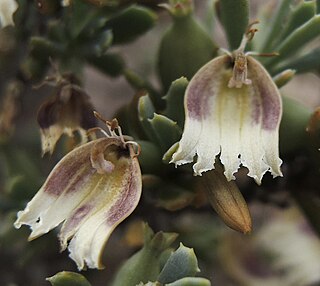
Scaevola collaris is a shrub in the family Goodeniaceae and its native range is five mainland states/territories of Australia: the Northern Territory, New South Wales, South Australia, Queensland and Western Australia.

Xanthosia atkinsoniana, is a small herb in the family Apiaceae. It grows in both New South Wales and Western Australia.

Tricoryne elatior is a species of flowering plant in the family Asphodelaceae, native to Australia, and found in all its states and territories.
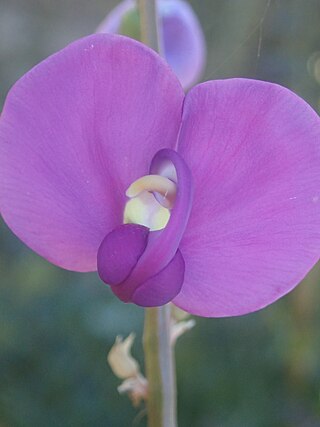
Swainsona procumbens is a plant in the pea family (Fabaceae) native to Australia and found in New South Wales, Victoria, Queensland and South Australia.

Glycine canescens, common name Silky Glycine, is trailing or twining herb. It is a species of soybean native to Australia. A perennial living across the Outback in extremely hot and dry conditions, it is being studied for its potential to improve the cultivated soybean . Grows in sandy or stony soils in a variety of habitats.

Dicrastylis lewellinii is a species of plant within the genus, Dicrastylis, in the family Lamiaceae. It is found in Western Australia, the Northern Territory, New South Wales, Queensland and South Australia.

Dicrastylis verticillata is a species of plant within the genus, Dicrastylis, in the family Lamiaceae. It is found in both South Australia and New South Wales.

Westringia rigida is a shrub in the Lamiaceae family that is endemic to Australia. and
Pullenia gunnii is a species of flowering plant in the legume family, Fabaceae. It is the sole species in genus Pullenia.

Eulalia aurea is a grass. It was first described as Andropogon aureum in 1804 by Bory de Saint-Vincent but was transferred to the genus, Eulalia, in 1830 by Kunth.

Peplidium foecundum is a plant in the Phrymaceae family, native to South Australia, Queensland, the Northern Territory and New South Wales.

Hybanthus floribundus is a plant in the Violaceae family, found in southern Western Australia, southern South Australia, Victoria and southern New South Wales.
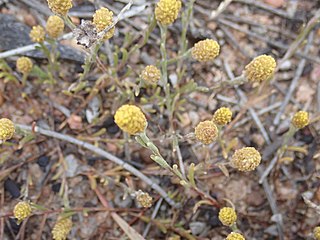
Calocephalus sonderi is a plant in the family Asteraceae, found in South Australia, Victoria, Queensland and New South Wales.



